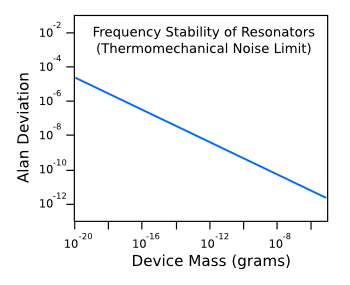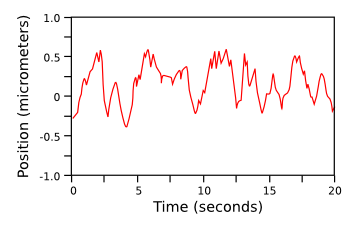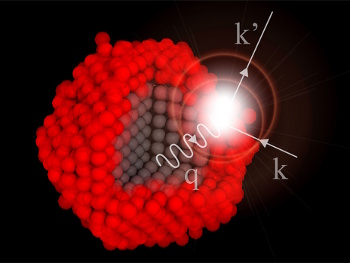The Nanoscale Shakes
May 2, 2016
There was much variety in
rock music at the start the
British Invasion in the
1960s, including a few, unusual,
minimalist recordings. One of these was
Hippy Hippy Shake, which was a somewhat popular release by
The Swinging Blue Jeans in 1964.[1] This song was
covered, also by
The Beatles on their
Live at the BBC album in 1994.

The hula hoop, a hip shaking phenomenon of the late 1950s and early 1960s.
An adult-sized hula hoop makes a good length reference, since they are almost exactly a meter in diameter. They became popular in the 1960s when Wham-O marketed a plastic version.
(A 1962 woodcut entitled, "Hoola Hoop," by an unknown artist, from the National Archives and Records Administration, National Archives Identifier, 558912, via Wikimedia Commons.)
Everything in the world suffers from a perpetual
shake. While higher
temperatures lead to greater
movement of atoms, even
atoms at
absolute zero shake, a consequence of
zero-point energy, a strange
quantum mechanical effect required by the
uncertainty principle. Liquid helium resists
freezing until application of
pressure because of its zero point energy.
Nanomechanical devices are becoming more common for use as
resonators and
sensors (see figure). Since nanomechanical resonators can be simply constructed right on a
silicon wafer and
fabricated to a desired
frequency, they're poised to overtake
century-old quartz crystal technology for frequency generation. Likewise, nanomechanical
cantilevers can be coated with
selective compounds to form extremely sensitive
biochemical sensors.

Left, a doubly-clamped beam resonator, right, a simple cantilever, each fabricated on a silicon wafer. The length dimension L of these devices is typically of the order of a micrometer (1000 nanometer), or less. Not shown are the connections for actuation, typically electrostatic, and sensing, typically piezoresistive. (Created using Inkscape.)
In devices as small as the ones in the above figure, any little thing can disrupt their normal operation. Aside from the temperature-induced shaking, called thermomechanical
noise, there's
electronic noise (
Nyquist–Johnson noise), noise caused by the
adsorption and
desorption of
gas molecules on the
surface, and even noise caused by the motion of
lattice defects in the silicon.[2-3]
The thermal noise, which acts as a fundamental limit to the frequency stability of a resonator, is quite apparent for small structures, as shown in the figure. For reference, a
quartz resonator crystal has a
mass of about a
gram.

Thermomechanical limit of resonator noise as a function of mass.
The Alan deviation is a measure of noise-induced frequency spread, (δf/f).
(Drawn using Inkscape from data in ref. 4.[4]
As the
authors of ref. 4 point out, high resonator
Q-factor and a little
integration aids in thermomechanical noise rejection. They conclude that a very small cantilever could sense the mass of a single
proton if it has a Q of about a 1000, and you're willing to integrate the
signal over a
millisecond.[4]
What can be smaller in mass than a
graphene cantilever? A team of
physicists and
engineers from
Cornell University (Ithaca, New York) fabricated a graphene cantilever with a
reflective gold patch on its end to facilitate measurement of the tip position with a
laser.[5] The affect of the impact of gas molecules is clearly seen in the figure below.

Movement of a 40 μm × 10 μm graphene cantilever caused by Brownian motion.
(Drawn using Inkscape from data in ref. 5.[5]
As I wrote in a
previous article (Sound and Heat, August 23, 2011),
phonons are the
quantized lattice vibrations that carry
heat in
solids. Electrical engineers and other researchers at
ETH Zurich (Zurich, Switzerland) and the
Paul Scherrer Institute (Villigen PSI, Switzerland), have examined how phonons interact with
electrons in
nanoscale materials. They've
published their findings in a recent issue of
Nature.[6-7]
As their
research demonstrates, vibrations at the outermost layers of a nanoparticle greatly affect the properties of the particle. This explains why nanoparticle-based
solar cells are not as efficient as expected, since the surface vibrations interact with electrons to reduce the
photocurrent.[7] Says ETH
professor,
Vanessa Wood, an author of the study,
"For some applications, like catalysis, thermoelectrics, or superconductivity, these large vibrations may be good, but for other applications like LEDs or solar cells, these vibrations are undesirable... Now that we have proven that surface vibrations are important, we can systematically design materials to suppress or enhance these vibrations."[7]

Artist's impression of a nanocrystal, showing the interaction of a phonon (q) with an electron wave vector (k).
(© ETH Zurich image by Deniz Bozyigit.)
This research explains one observation involving nanocrystals used in solar cells, that a coating layer improves
efficiency. A hard shell of atoms will suppress the surface vibrations.[7]
References:
- Swinging Blue Jeans, The Hippy Hippy Shake, YouTube Video by TheVideoJukeBox4, January 11, 2012.
- A. N. Cleland and M. L. Roukes, "Noise processes in nanomechanical resonators," J. Appl. Phys., vol. 92, no. 5 (September 1, 2012), pp. 2758-2769, doi: 10.1063/1.1499745. A PDF version of this paper can be found here.
- A. N. Cleland, "Thermomechanical noise limits on parametric sensing with nanomechanical resonators," New Journal of Physics,vol. 7 (November 29, 2005), pp. 235-251.
- Marc Sansa, Eric Sage, Elizabeth C. Bullard, Marc Gély, Thomas Alava, Eric Colinet, Akshay K. Naik, Luis Guillermo Villanueva, Laurent Duraffourg, Michael L. Roukes, Guillaume Jourdan, Sébastien Hentz, "Frequency fluctuations in silicon nanoresonators," Nature Nanotechnology, February 29, 2016, doi:10.1038/nnano.2016.19. Available also on arXiv.
- Melina K. Blees, Arthur W. Barnard, Peter A. Rose, Samantha P. Roberts, Kathryn L. McGill, Pinshane Y. Huang, Alexander R. Ruyack, Joshua W. Kevek, Bryce Kobrin, David A. Muller, and Paul L. McEuen, "Graphene kirigami," Nature, vol. 524, no. 7564 (August 13, 2015, pp. 204-207, doi:10.1038/nature14588.
- Deniz Bozyigit, Nuri Yazdani, Maksym Yarema, Olesya Yarema, Weyde Matteo Mario Lin, Sebastian Volk, Kantawong Vuttivorakulchai, Mathieu Luisier, Fanni Juranyi, and Vanessa Wood, "Soft surfaces of nanomaterials enable strong phonon interactions," Nature, Advanced Online Publication (March 9, 2016), doi:10.1038/nature16977.
- Atomic Vibrations in Nanomaterials, ETH-Zurich Press Release, March 9, 2016.
- Nuri Yazdani, Animation of a vibrating lead sulfide nanocrystal (1.7 MB MP4 File).
Permanent Link to this article
Linked Keywords: Rock music; British Invasion; 1960s; minimal music; minimalist; gramophone record; recording; Hippy Hippy Shake; The Swinging Blue Jeans; cover version; covered; The Beatles; Live at the BBC; hula hoop; hip; phenomenon; 1950s; adult-sized; length; reference; meter; diameter; Wham-O; plastic; woodcut; artist; National Archives and Records Administration; Wikimedia Commons; vibration; shake; temperature; atom vibration; movement of atoms; atoms; absolute zero; zero-point energy; quantum mechanics; quantum mechanical; uncertainty principle; liquid helium; freezing; pressure; nanomechanics; nanomechanical devices; resonance; resonator; sensor; silicon wafer; microfabrication; fabricate; frequency; century; quartz crystal; technology; cantilever; immunoassay; biochemistry; biochemical; micrometer; nanometer; electrostatic; sensing; piezoresistive; Inkscape; noise; electronic noise; Nyquist–Johnson noise; adsorption; desorption; gas molecule; surface; lattice defect; quartz resonator crystal; mass; gram; spectral width; frequency spread; author; Q-factor; integrator circuit; integration; proton; signal; millisecond; graphene; physicist; engineer; Cornell University (Ithaca, New York); reflection; reflective; gold; laser; graphene; cantilever; Brownian motion; phonon; quantization; quantized; normal mode; lattice vibration; heat; solid; electrical engineer; ETH Zurich (Zurich, Switzerland); Paul Scherrer Institute (Villigen PSI, Switzerland); electron; nanoscopic scale; nanoscale; material; scientific literature; publish; Nature; research; solar cell; photocurrent; professor; Vanessa Wood; catalysis; thermoelectric material; thermoelectric; superconductivity; light-emitting diode; LED; wave vector; energy conversion efficiency.